Partnership in Health and Social Care: Analysis and Improvement
VerifiedAdded on 2024/06/11
|13
|4872
|255
Report
AI Summary
This report examines partnership working in health and social care, focusing on key philosophies such as empowerment, respect, independence, and informed decision-making. It analyzes partnership relationships, including those between healthcare professionals, patient-carers, and agencies, highlighting the importance of effective communication and collaboration. Different partnership models, including unified, coalition, and hybrid models, are discussed, along with relevant legislation and organizational policies. The report also explores the outcomes of partnership working for service users, professionals, and organizations, identifies barriers to effective teamwork, such as lack of communication and differing working practices, and recommends strategies to improve partnership working, including proper supervision and leadership. A case study illustrates the challenges of failed partnership due to inadequate communication between agencies, emphasizing the need for enhanced collaboration to ensure positive outcomes for service users.
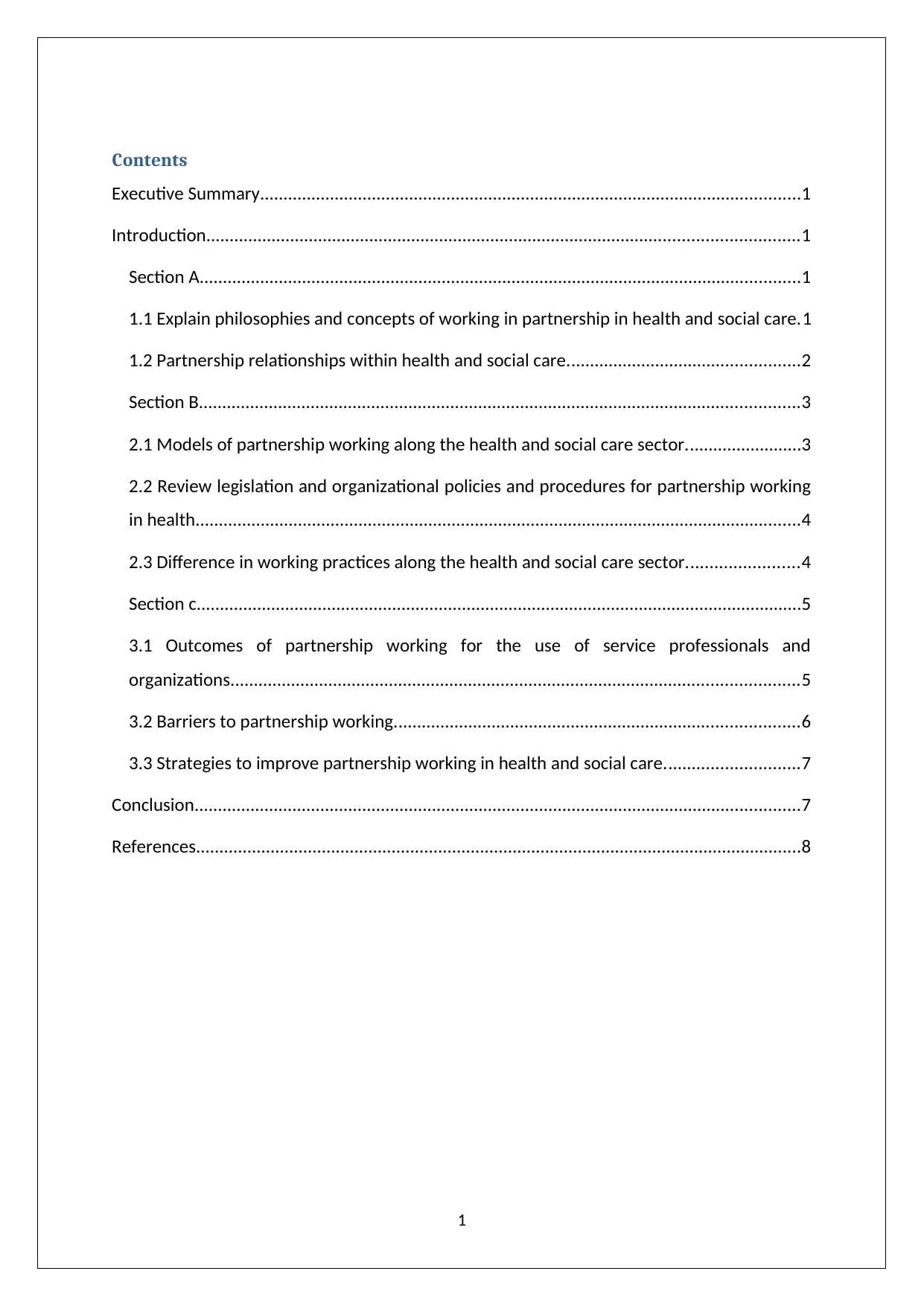
Contents
Executive Summary....................................................................................................................1
Introduction...............................................................................................................................1
Section A.................................................................................................................................1
1.1 Explain philosophies and concepts of working in partnership in health and social care.1
1.2 Partnership relationships within health and social care..................................................2
Section B.................................................................................................................................3
2.1 Models of partnership working along the health and social care sector.........................3
2.2 Review legislation and organizational policies and procedures for partnership working
in health..................................................................................................................................4
2.3 Difference in working practices along the health and social care sector........................4
Section c..................................................................................................................................5
3.1 Outcomes of partnership working for the use of service professionals and
organizations..........................................................................................................................5
3.2 Barriers to partnership working.......................................................................................6
3.3 Strategies to improve partnership working in health and social care.............................7
Conclusion..................................................................................................................................7
References..................................................................................................................................8
1
Executive Summary....................................................................................................................1
Introduction...............................................................................................................................1
Section A.................................................................................................................................1
1.1 Explain philosophies and concepts of working in partnership in health and social care.1
1.2 Partnership relationships within health and social care..................................................2
Section B.................................................................................................................................3
2.1 Models of partnership working along the health and social care sector.........................3
2.2 Review legislation and organizational policies and procedures for partnership working
in health..................................................................................................................................4
2.3 Difference in working practices along the health and social care sector........................4
Section c..................................................................................................................................5
3.1 Outcomes of partnership working for the use of service professionals and
organizations..........................................................................................................................5
3.2 Barriers to partnership working.......................................................................................6
3.3 Strategies to improve partnership working in health and social care.............................7
Conclusion..................................................................................................................................7
References..................................................................................................................................8
1
Paraphrase This Document
Need a fresh take? Get an instant paraphrase of this document with our AI Paraphraser
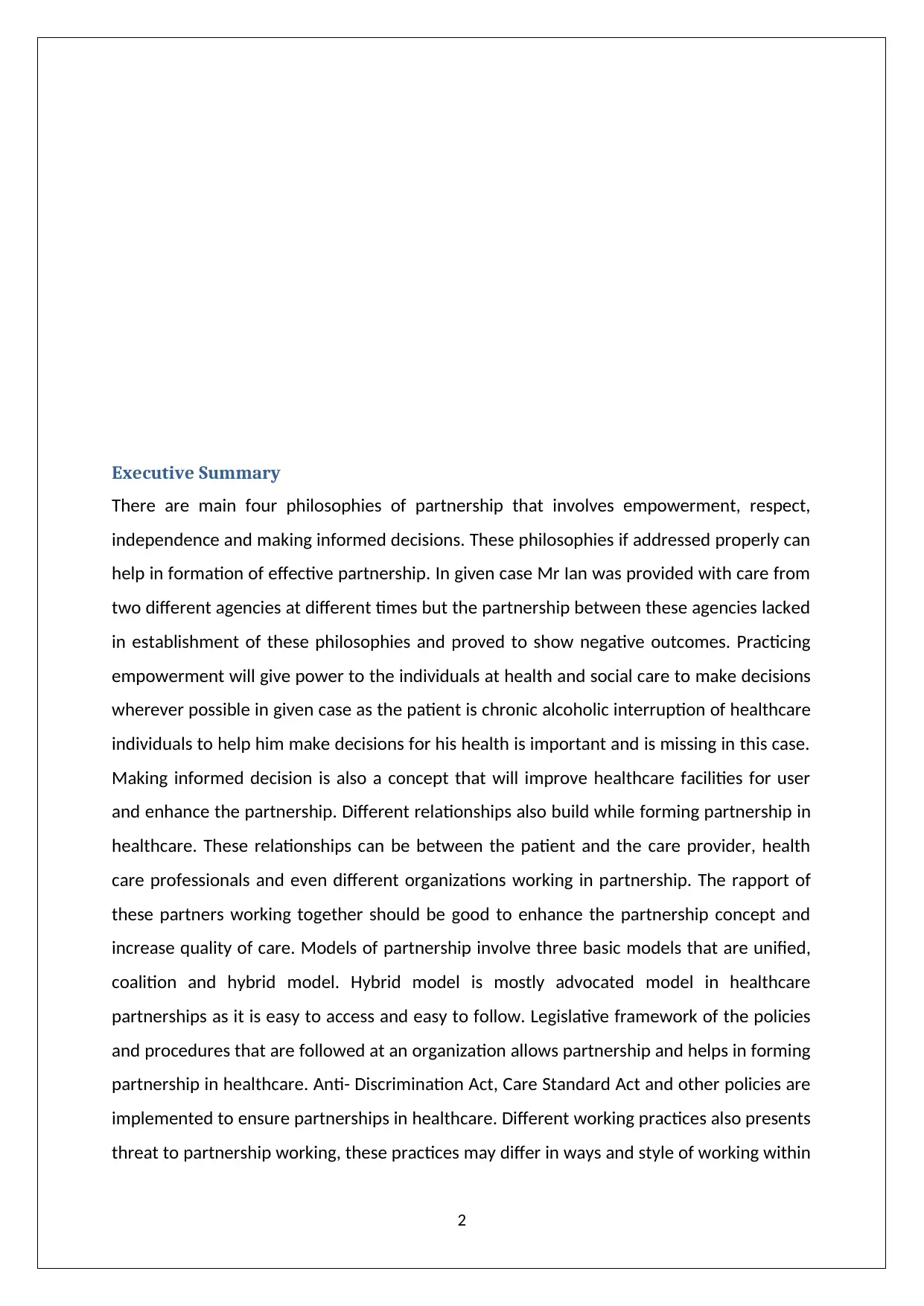
Executive Summary
There are main four philosophies of partnership that involves empowerment, respect,
independence and making informed decisions. These philosophies if addressed properly can
help in formation of effective partnership. In given case Mr Ian was provided with care from
two different agencies at different times but the partnership between these agencies lacked
in establishment of these philosophies and proved to show negative outcomes. Practicing
empowerment will give power to the individuals at health and social care to make decisions
wherever possible in given case as the patient is chronic alcoholic interruption of healthcare
individuals to help him make decisions for his health is important and is missing in this case.
Making informed decision is also a concept that will improve healthcare facilities for user
and enhance the partnership. Different relationships also build while forming partnership in
healthcare. These relationships can be between the patient and the care provider, health
care professionals and even different organizations working in partnership. The rapport of
these partners working together should be good to enhance the partnership concept and
increase quality of care. Models of partnership involve three basic models that are unified,
coalition and hybrid model. Hybrid model is mostly advocated model in healthcare
partnerships as it is easy to access and easy to follow. Legislative framework of the policies
and procedures that are followed at an organization allows partnership and helps in forming
partnership in healthcare. Anti- Discrimination Act, Care Standard Act and other policies are
implemented to ensure partnerships in healthcare. Different working practices also presents
threat to partnership working, these practices may differ in ways and style of working within
2
There are main four philosophies of partnership that involves empowerment, respect,
independence and making informed decisions. These philosophies if addressed properly can
help in formation of effective partnership. In given case Mr Ian was provided with care from
two different agencies at different times but the partnership between these agencies lacked
in establishment of these philosophies and proved to show negative outcomes. Practicing
empowerment will give power to the individuals at health and social care to make decisions
wherever possible in given case as the patient is chronic alcoholic interruption of healthcare
individuals to help him make decisions for his health is important and is missing in this case.
Making informed decision is also a concept that will improve healthcare facilities for user
and enhance the partnership. Different relationships also build while forming partnership in
healthcare. These relationships can be between the patient and the care provider, health
care professionals and even different organizations working in partnership. The rapport of
these partners working together should be good to enhance the partnership concept and
increase quality of care. Models of partnership involve three basic models that are unified,
coalition and hybrid model. Hybrid model is mostly advocated model in healthcare
partnerships as it is easy to access and easy to follow. Legislative framework of the policies
and procedures that are followed at an organization allows partnership and helps in forming
partnership in healthcare. Anti- Discrimination Act, Care Standard Act and other policies are
implemented to ensure partnerships in healthcare. Different working practices also presents
threat to partnership working, these practices may differ in ways and style of working within
2
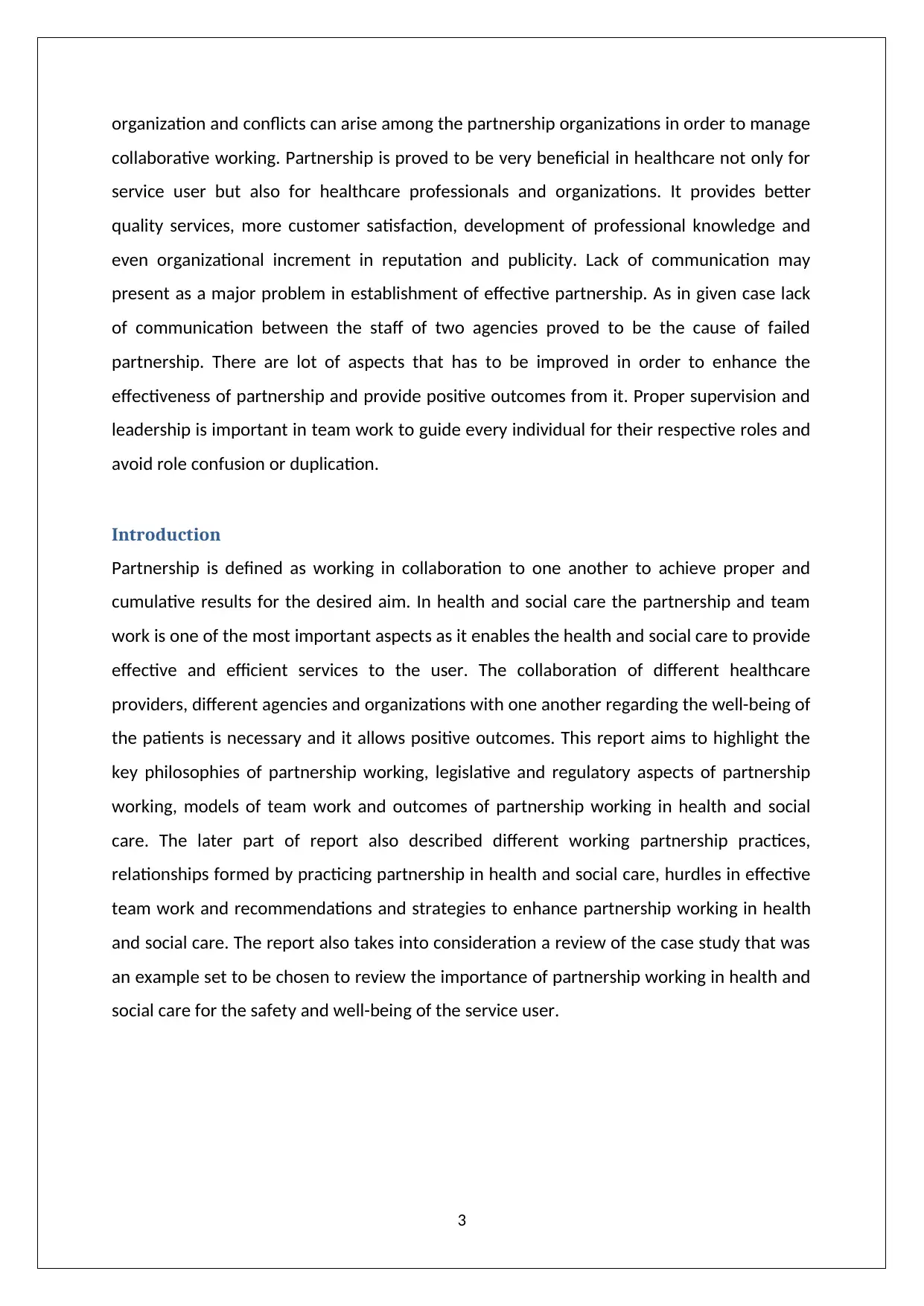
organization and conflicts can arise among the partnership organizations in order to manage
collaborative working. Partnership is proved to be very beneficial in healthcare not only for
service user but also for healthcare professionals and organizations. It provides better
quality services, more customer satisfaction, development of professional knowledge and
even organizational increment in reputation and publicity. Lack of communication may
present as a major problem in establishment of effective partnership. As in given case lack
of communication between the staff of two agencies proved to be the cause of failed
partnership. There are lot of aspects that has to be improved in order to enhance the
effectiveness of partnership and provide positive outcomes from it. Proper supervision and
leadership is important in team work to guide every individual for their respective roles and
avoid role confusion or duplication.
Introduction
Partnership is defined as working in collaboration to one another to achieve proper and
cumulative results for the desired aim. In health and social care the partnership and team
work is one of the most important aspects as it enables the health and social care to provide
effective and efficient services to the user. The collaboration of different healthcare
providers, different agencies and organizations with one another regarding the well-being of
the patients is necessary and it allows positive outcomes. This report aims to highlight the
key philosophies of partnership working, legislative and regulatory aspects of partnership
working, models of team work and outcomes of partnership working in health and social
care. The later part of report also described different working partnership practices,
relationships formed by practicing partnership in health and social care, hurdles in effective
team work and recommendations and strategies to enhance partnership working in health
and social care. The report also takes into consideration a review of the case study that was
an example set to be chosen to review the importance of partnership working in health and
social care for the safety and well-being of the service user.
3
collaborative working. Partnership is proved to be very beneficial in healthcare not only for
service user but also for healthcare professionals and organizations. It provides better
quality services, more customer satisfaction, development of professional knowledge and
even organizational increment in reputation and publicity. Lack of communication may
present as a major problem in establishment of effective partnership. As in given case lack
of communication between the staff of two agencies proved to be the cause of failed
partnership. There are lot of aspects that has to be improved in order to enhance the
effectiveness of partnership and provide positive outcomes from it. Proper supervision and
leadership is important in team work to guide every individual for their respective roles and
avoid role confusion or duplication.
Introduction
Partnership is defined as working in collaboration to one another to achieve proper and
cumulative results for the desired aim. In health and social care the partnership and team
work is one of the most important aspects as it enables the health and social care to provide
effective and efficient services to the user. The collaboration of different healthcare
providers, different agencies and organizations with one another regarding the well-being of
the patients is necessary and it allows positive outcomes. This report aims to highlight the
key philosophies of partnership working, legislative and regulatory aspects of partnership
working, models of team work and outcomes of partnership working in health and social
care. The later part of report also described different working partnership practices,
relationships formed by practicing partnership in health and social care, hurdles in effective
team work and recommendations and strategies to enhance partnership working in health
and social care. The report also takes into consideration a review of the case study that was
an example set to be chosen to review the importance of partnership working in health and
social care for the safety and well-being of the service user.
3
⊘ This is a preview!⊘
Do you want full access?
Subscribe today to unlock all pages.

Trusted by 1+ million students worldwide
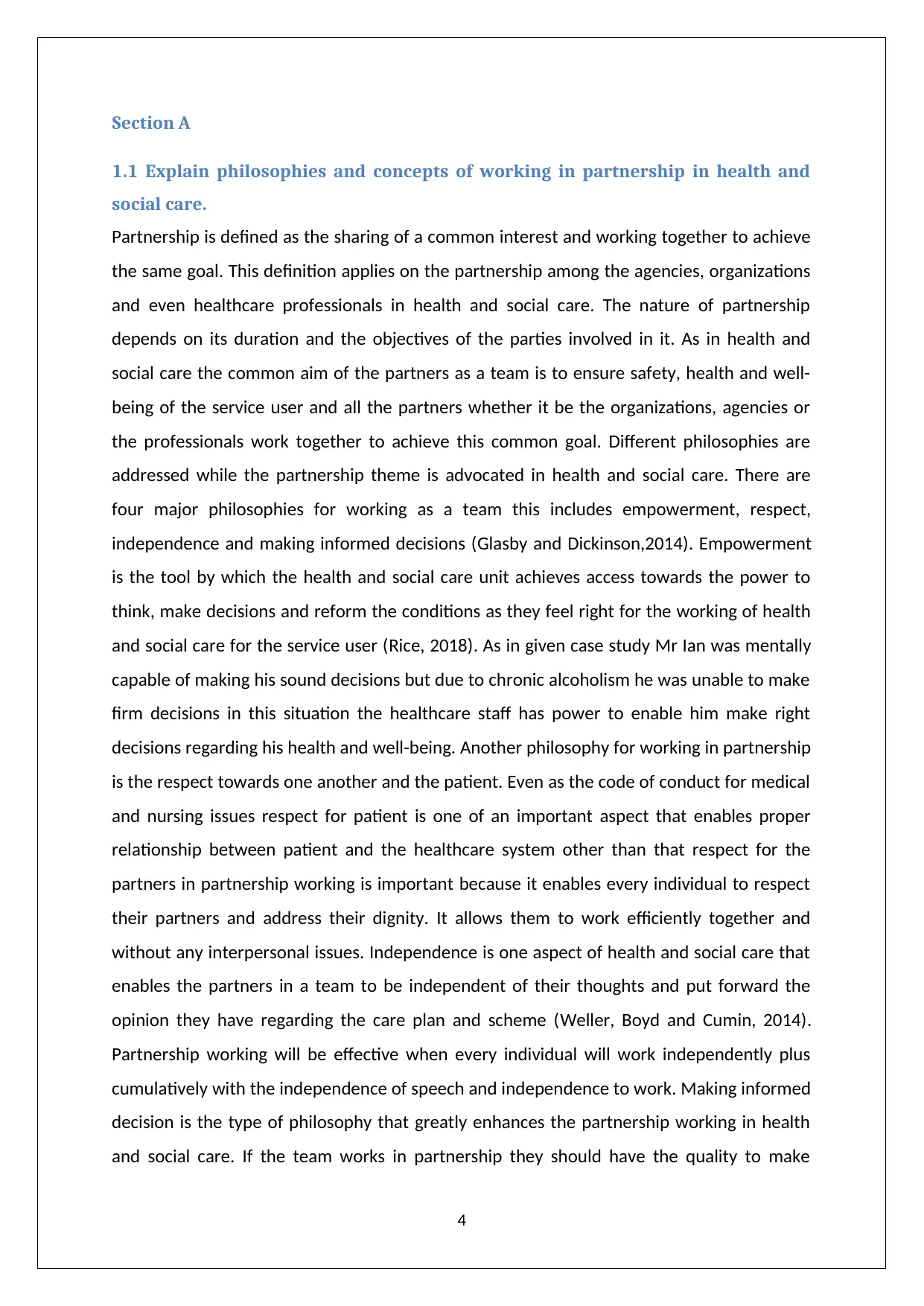
Section A
1.1 Explain philosophies and concepts of working in partnership in health and
social care.
Partnership is defined as the sharing of a common interest and working together to achieve
the same goal. This definition applies on the partnership among the agencies, organizations
and even healthcare professionals in health and social care. The nature of partnership
depends on its duration and the objectives of the parties involved in it. As in health and
social care the common aim of the partners as a team is to ensure safety, health and well-
being of the service user and all the partners whether it be the organizations, agencies or
the professionals work together to achieve this common goal. Different philosophies are
addressed while the partnership theme is advocated in health and social care. There are
four major philosophies for working as a team this includes empowerment, respect,
independence and making informed decisions (Glasby and Dickinson,2014). Empowerment
is the tool by which the health and social care unit achieves access towards the power to
think, make decisions and reform the conditions as they feel right for the working of health
and social care for the service user (Rice, 2018). As in given case study Mr Ian was mentally
capable of making his sound decisions but due to chronic alcoholism he was unable to make
firm decisions in this situation the healthcare staff has power to enable him make right
decisions regarding his health and well-being. Another philosophy for working in partnership
is the respect towards one another and the patient. Even as the code of conduct for medical
and nursing issues respect for patient is one of an important aspect that enables proper
relationship between patient and the healthcare system other than that respect for the
partners in partnership working is important because it enables every individual to respect
their partners and address their dignity. It allows them to work efficiently together and
without any interpersonal issues. Independence is one aspect of health and social care that
enables the partners in a team to be independent of their thoughts and put forward the
opinion they have regarding the care plan and scheme (Weller, Boyd and Cumin, 2014).
Partnership working will be effective when every individual will work independently plus
cumulatively with the independence of speech and independence to work. Making informed
decision is the type of philosophy that greatly enhances the partnership working in health
and social care. If the team works in partnership they should have the quality to make
4
1.1 Explain philosophies and concepts of working in partnership in health and
social care.
Partnership is defined as the sharing of a common interest and working together to achieve
the same goal. This definition applies on the partnership among the agencies, organizations
and even healthcare professionals in health and social care. The nature of partnership
depends on its duration and the objectives of the parties involved in it. As in health and
social care the common aim of the partners as a team is to ensure safety, health and well-
being of the service user and all the partners whether it be the organizations, agencies or
the professionals work together to achieve this common goal. Different philosophies are
addressed while the partnership theme is advocated in health and social care. There are
four major philosophies for working as a team this includes empowerment, respect,
independence and making informed decisions (Glasby and Dickinson,2014). Empowerment
is the tool by which the health and social care unit achieves access towards the power to
think, make decisions and reform the conditions as they feel right for the working of health
and social care for the service user (Rice, 2018). As in given case study Mr Ian was mentally
capable of making his sound decisions but due to chronic alcoholism he was unable to make
firm decisions in this situation the healthcare staff has power to enable him make right
decisions regarding his health and well-being. Another philosophy for working in partnership
is the respect towards one another and the patient. Even as the code of conduct for medical
and nursing issues respect for patient is one of an important aspect that enables proper
relationship between patient and the healthcare system other than that respect for the
partners in partnership working is important because it enables every individual to respect
their partners and address their dignity. It allows them to work efficiently together and
without any interpersonal issues. Independence is one aspect of health and social care that
enables the partners in a team to be independent of their thoughts and put forward the
opinion they have regarding the care plan and scheme (Weller, Boyd and Cumin, 2014).
Partnership working will be effective when every individual will work independently plus
cumulatively with the independence of speech and independence to work. Making informed
decision is the type of philosophy that greatly enhances the partnership working in health
and social care. If the team works in partnership they should have the quality to make
4
Paraphrase This Document
Need a fresh take? Get an instant paraphrase of this document with our AI Paraphraser
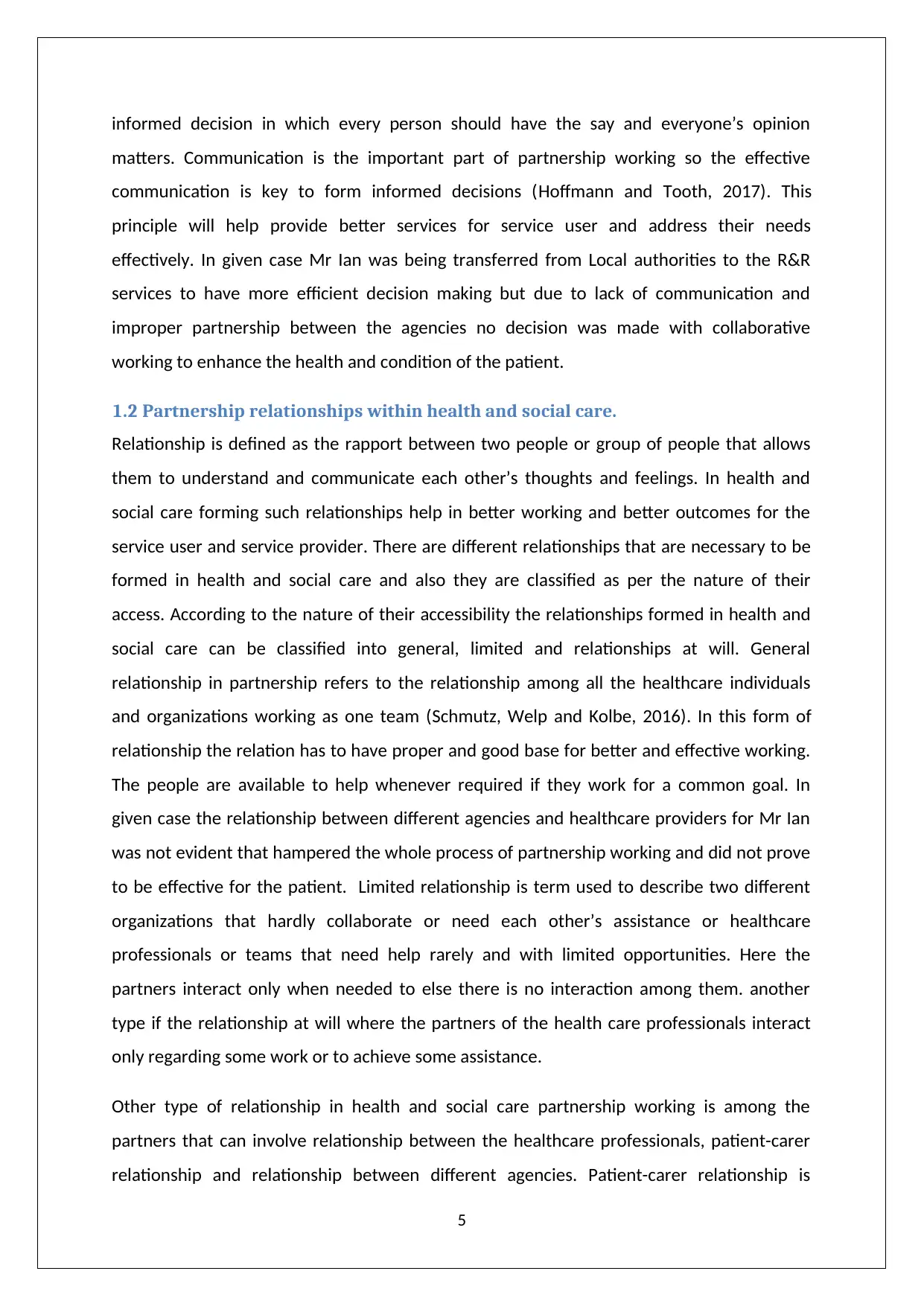
informed decision in which every person should have the say and everyone’s opinion
matters. Communication is the important part of partnership working so the effective
communication is key to form informed decisions (Hoffmann and Tooth, 2017). This
principle will help provide better services for service user and address their needs
effectively. In given case Mr Ian was being transferred from Local authorities to the R&R
services to have more efficient decision making but due to lack of communication and
improper partnership between the agencies no decision was made with collaborative
working to enhance the health and condition of the patient.
1.2 Partnership relationships within health and social care.
Relationship is defined as the rapport between two people or group of people that allows
them to understand and communicate each other’s thoughts and feelings. In health and
social care forming such relationships help in better working and better outcomes for the
service user and service provider. There are different relationships that are necessary to be
formed in health and social care and also they are classified as per the nature of their
access. According to the nature of their accessibility the relationships formed in health and
social care can be classified into general, limited and relationships at will. General
relationship in partnership refers to the relationship among all the healthcare individuals
and organizations working as one team (Schmutz, Welp and Kolbe, 2016). In this form of
relationship the relation has to have proper and good base for better and effective working.
The people are available to help whenever required if they work for a common goal. In
given case the relationship between different agencies and healthcare providers for Mr Ian
was not evident that hampered the whole process of partnership working and did not prove
to be effective for the patient. Limited relationship is term used to describe two different
organizations that hardly collaborate or need each other’s assistance or healthcare
professionals or teams that need help rarely and with limited opportunities. Here the
partners interact only when needed to else there is no interaction among them. another
type if the relationship at will where the partners of the health care professionals interact
only regarding some work or to achieve some assistance.
Other type of relationship in health and social care partnership working is among the
partners that can involve relationship between the healthcare professionals, patient-carer
relationship and relationship between different agencies. Patient-carer relationship is
5
matters. Communication is the important part of partnership working so the effective
communication is key to form informed decisions (Hoffmann and Tooth, 2017). This
principle will help provide better services for service user and address their needs
effectively. In given case Mr Ian was being transferred from Local authorities to the R&R
services to have more efficient decision making but due to lack of communication and
improper partnership between the agencies no decision was made with collaborative
working to enhance the health and condition of the patient.
1.2 Partnership relationships within health and social care.
Relationship is defined as the rapport between two people or group of people that allows
them to understand and communicate each other’s thoughts and feelings. In health and
social care forming such relationships help in better working and better outcomes for the
service user and service provider. There are different relationships that are necessary to be
formed in health and social care and also they are classified as per the nature of their
access. According to the nature of their accessibility the relationships formed in health and
social care can be classified into general, limited and relationships at will. General
relationship in partnership refers to the relationship among all the healthcare individuals
and organizations working as one team (Schmutz, Welp and Kolbe, 2016). In this form of
relationship the relation has to have proper and good base for better and effective working.
The people are available to help whenever required if they work for a common goal. In
given case the relationship between different agencies and healthcare providers for Mr Ian
was not evident that hampered the whole process of partnership working and did not prove
to be effective for the patient. Limited relationship is term used to describe two different
organizations that hardly collaborate or need each other’s assistance or healthcare
professionals or teams that need help rarely and with limited opportunities. Here the
partners interact only when needed to else there is no interaction among them. another
type if the relationship at will where the partners of the health care professionals interact
only regarding some work or to achieve some assistance.
Other type of relationship in health and social care partnership working is among the
partners that can involve relationship between the healthcare professionals, patient-carer
relationship and relationship between different agencies. Patient-carer relationship is
5
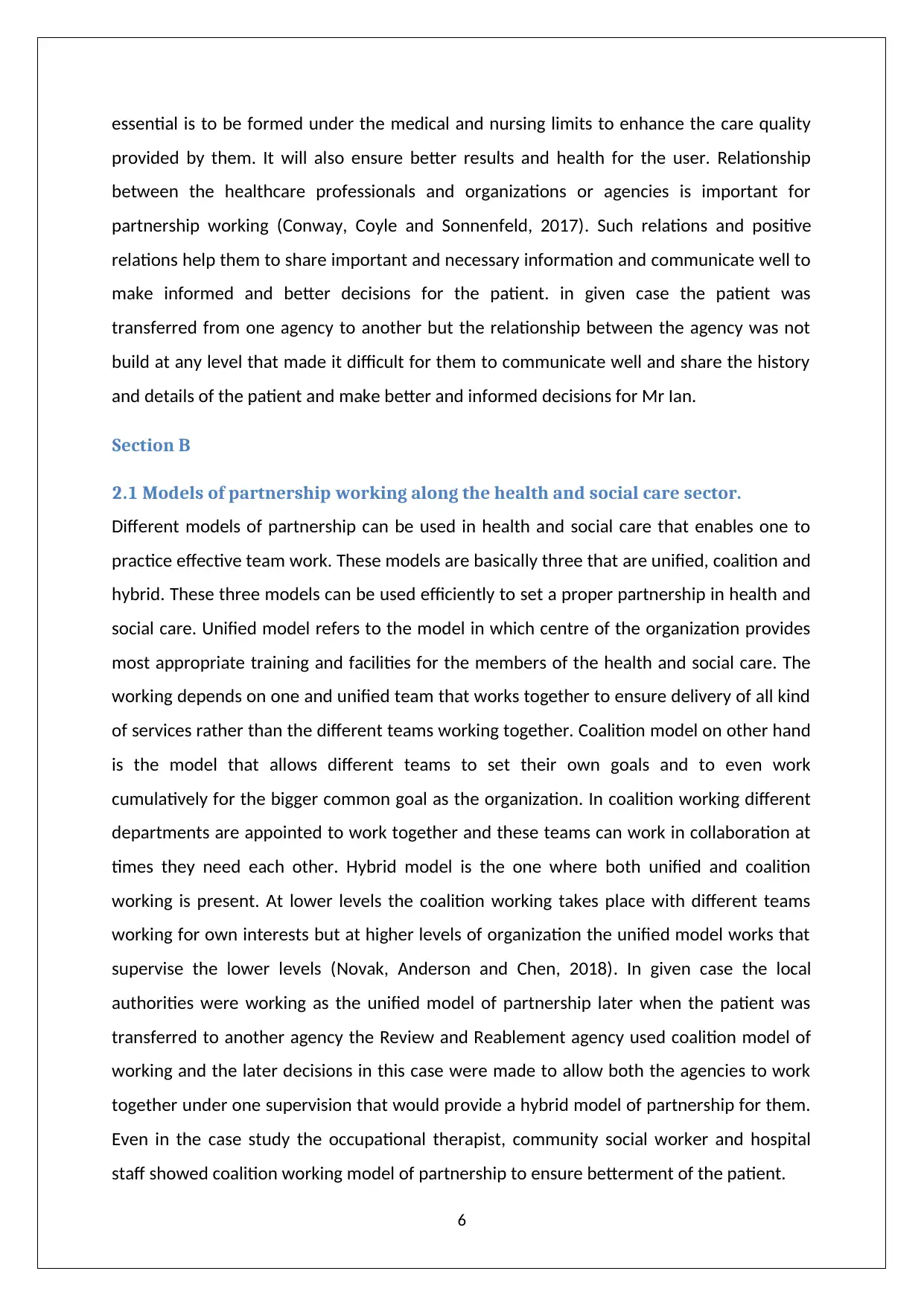
essential is to be formed under the medical and nursing limits to enhance the care quality
provided by them. It will also ensure better results and health for the user. Relationship
between the healthcare professionals and organizations or agencies is important for
partnership working (Conway, Coyle and Sonnenfeld, 2017). Such relations and positive
relations help them to share important and necessary information and communicate well to
make informed and better decisions for the patient. in given case the patient was
transferred from one agency to another but the relationship between the agency was not
build at any level that made it difficult for them to communicate well and share the history
and details of the patient and make better and informed decisions for Mr Ian.
Section B
2.1 Models of partnership working along the health and social care sector.
Different models of partnership can be used in health and social care that enables one to
practice effective team work. These models are basically three that are unified, coalition and
hybrid. These three models can be used efficiently to set a proper partnership in health and
social care. Unified model refers to the model in which centre of the organization provides
most appropriate training and facilities for the members of the health and social care. The
working depends on one and unified team that works together to ensure delivery of all kind
of services rather than the different teams working together. Coalition model on other hand
is the model that allows different teams to set their own goals and to even work
cumulatively for the bigger common goal as the organization. In coalition working different
departments are appointed to work together and these teams can work in collaboration at
times they need each other. Hybrid model is the one where both unified and coalition
working is present. At lower levels the coalition working takes place with different teams
working for own interests but at higher levels of organization the unified model works that
supervise the lower levels (Novak, Anderson and Chen, 2018). In given case the local
authorities were working as the unified model of partnership later when the patient was
transferred to another agency the Review and Reablement agency used coalition model of
working and the later decisions in this case were made to allow both the agencies to work
together under one supervision that would provide a hybrid model of partnership for them.
Even in the case study the occupational therapist, community social worker and hospital
staff showed coalition working model of partnership to ensure betterment of the patient.
6
provided by them. It will also ensure better results and health for the user. Relationship
between the healthcare professionals and organizations or agencies is important for
partnership working (Conway, Coyle and Sonnenfeld, 2017). Such relations and positive
relations help them to share important and necessary information and communicate well to
make informed and better decisions for the patient. in given case the patient was
transferred from one agency to another but the relationship between the agency was not
build at any level that made it difficult for them to communicate well and share the history
and details of the patient and make better and informed decisions for Mr Ian.
Section B
2.1 Models of partnership working along the health and social care sector.
Different models of partnership can be used in health and social care that enables one to
practice effective team work. These models are basically three that are unified, coalition and
hybrid. These three models can be used efficiently to set a proper partnership in health and
social care. Unified model refers to the model in which centre of the organization provides
most appropriate training and facilities for the members of the health and social care. The
working depends on one and unified team that works together to ensure delivery of all kind
of services rather than the different teams working together. Coalition model on other hand
is the model that allows different teams to set their own goals and to even work
cumulatively for the bigger common goal as the organization. In coalition working different
departments are appointed to work together and these teams can work in collaboration at
times they need each other. Hybrid model is the one where both unified and coalition
working is present. At lower levels the coalition working takes place with different teams
working for own interests but at higher levels of organization the unified model works that
supervise the lower levels (Novak, Anderson and Chen, 2018). In given case the local
authorities were working as the unified model of partnership later when the patient was
transferred to another agency the Review and Reablement agency used coalition model of
working and the later decisions in this case were made to allow both the agencies to work
together under one supervision that would provide a hybrid model of partnership for them.
Even in the case study the occupational therapist, community social worker and hospital
staff showed coalition working model of partnership to ensure betterment of the patient.
6
⊘ This is a preview!⊘
Do you want full access?
Subscribe today to unlock all pages.

Trusted by 1+ million students worldwide
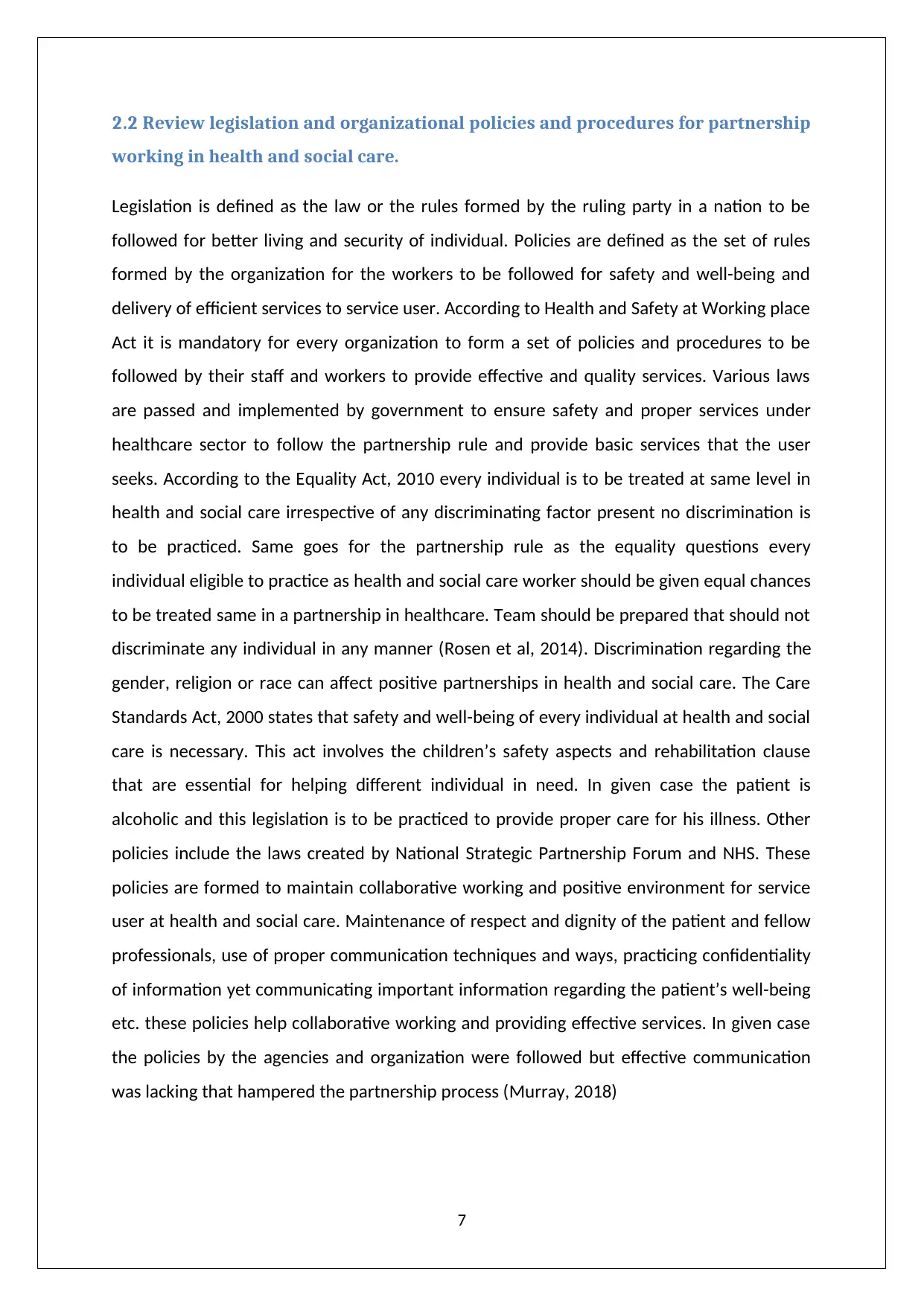
2.2 Review legislation and organizational policies and procedures for partnership
working in health and social care.
Legislation is defined as the law or the rules formed by the ruling party in a nation to be
followed for better living and security of individual. Policies are defined as the set of rules
formed by the organization for the workers to be followed for safety and well-being and
delivery of efficient services to service user. According to Health and Safety at Working place
Act it is mandatory for every organization to form a set of policies and procedures to be
followed by their staff and workers to provide effective and quality services. Various laws
are passed and implemented by government to ensure safety and proper services under
healthcare sector to follow the partnership rule and provide basic services that the user
seeks. According to the Equality Act, 2010 every individual is to be treated at same level in
health and social care irrespective of any discriminating factor present no discrimination is
to be practiced. Same goes for the partnership rule as the equality questions every
individual eligible to practice as health and social care worker should be given equal chances
to be treated same in a partnership in healthcare. Team should be prepared that should not
discriminate any individual in any manner (Rosen et al, 2014). Discrimination regarding the
gender, religion or race can affect positive partnerships in health and social care. The Care
Standards Act, 2000 states that safety and well-being of every individual at health and social
care is necessary. This act involves the children’s safety aspects and rehabilitation clause
that are essential for helping different individual in need. In given case the patient is
alcoholic and this legislation is to be practiced to provide proper care for his illness. Other
policies include the laws created by National Strategic Partnership Forum and NHS. These
policies are formed to maintain collaborative working and positive environment for service
user at health and social care. Maintenance of respect and dignity of the patient and fellow
professionals, use of proper communication techniques and ways, practicing confidentiality
of information yet communicating important information regarding the patient’s well-being
etc. these policies help collaborative working and providing effective services. In given case
the policies by the agencies and organization were followed but effective communication
was lacking that hampered the partnership process (Murray, 2018)
7
working in health and social care.
Legislation is defined as the law or the rules formed by the ruling party in a nation to be
followed for better living and security of individual. Policies are defined as the set of rules
formed by the organization for the workers to be followed for safety and well-being and
delivery of efficient services to service user. According to Health and Safety at Working place
Act it is mandatory for every organization to form a set of policies and procedures to be
followed by their staff and workers to provide effective and quality services. Various laws
are passed and implemented by government to ensure safety and proper services under
healthcare sector to follow the partnership rule and provide basic services that the user
seeks. According to the Equality Act, 2010 every individual is to be treated at same level in
health and social care irrespective of any discriminating factor present no discrimination is
to be practiced. Same goes for the partnership rule as the equality questions every
individual eligible to practice as health and social care worker should be given equal chances
to be treated same in a partnership in healthcare. Team should be prepared that should not
discriminate any individual in any manner (Rosen et al, 2014). Discrimination regarding the
gender, religion or race can affect positive partnerships in health and social care. The Care
Standards Act, 2000 states that safety and well-being of every individual at health and social
care is necessary. This act involves the children’s safety aspects and rehabilitation clause
that are essential for helping different individual in need. In given case the patient is
alcoholic and this legislation is to be practiced to provide proper care for his illness. Other
policies include the laws created by National Strategic Partnership Forum and NHS. These
policies are formed to maintain collaborative working and positive environment for service
user at health and social care. Maintenance of respect and dignity of the patient and fellow
professionals, use of proper communication techniques and ways, practicing confidentiality
of information yet communicating important information regarding the patient’s well-being
etc. these policies help collaborative working and providing effective services. In given case
the policies by the agencies and organization were followed but effective communication
was lacking that hampered the partnership process (Murray, 2018)
7
Paraphrase This Document
Need a fresh take? Get an instant paraphrase of this document with our AI Paraphraser
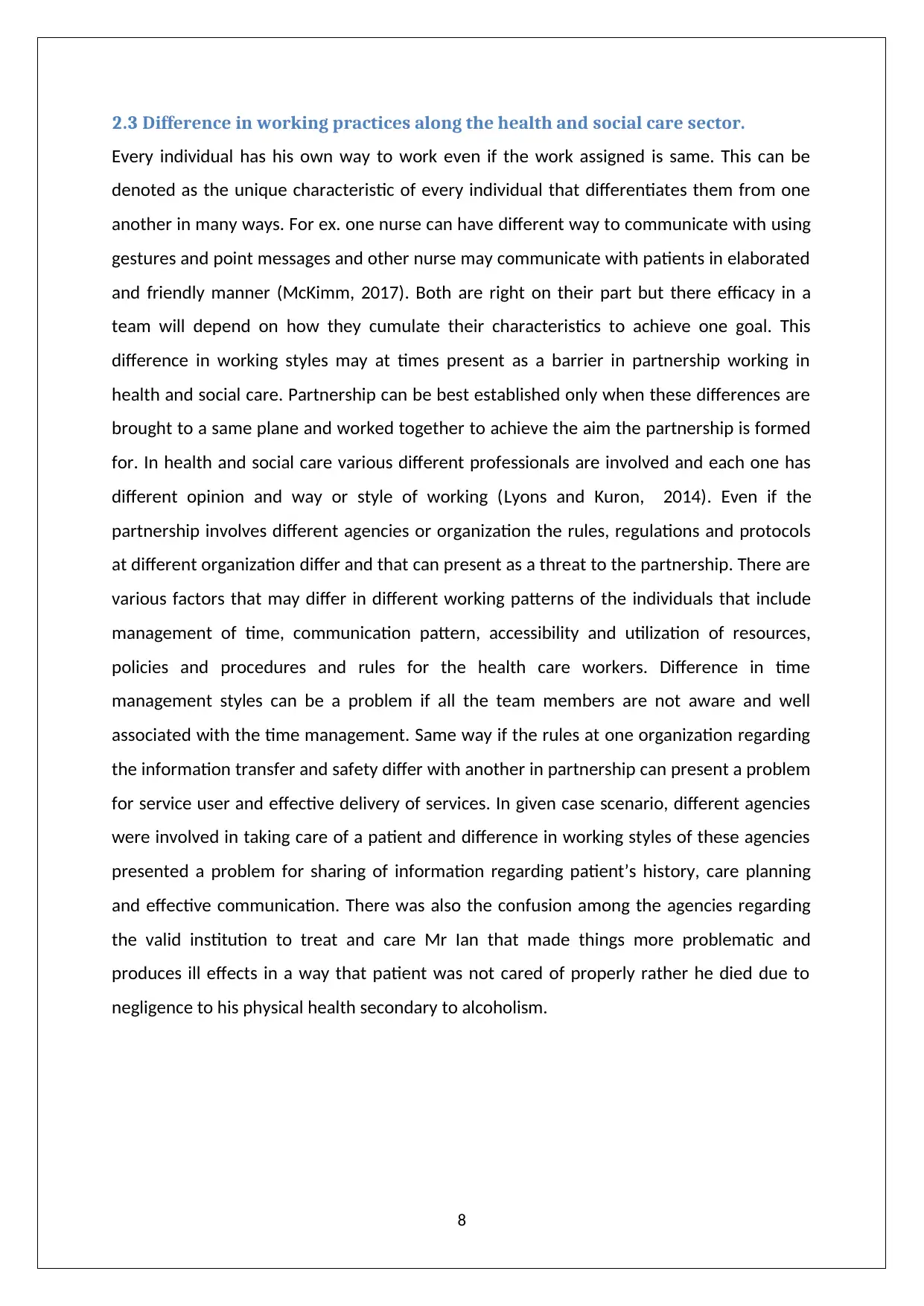
2.3 Difference in working practices along the health and social care sector.
Every individual has his own way to work even if the work assigned is same. This can be
denoted as the unique characteristic of every individual that differentiates them from one
another in many ways. For ex. one nurse can have different way to communicate with using
gestures and point messages and other nurse may communicate with patients in elaborated
and friendly manner (McKimm, 2017). Both are right on their part but there efficacy in a
team will depend on how they cumulate their characteristics to achieve one goal. This
difference in working styles may at times present as a barrier in partnership working in
health and social care. Partnership can be best established only when these differences are
brought to a same plane and worked together to achieve the aim the partnership is formed
for. In health and social care various different professionals are involved and each one has
different opinion and way or style of working (Lyons and Kuron, 2014). Even if the
partnership involves different agencies or organization the rules, regulations and protocols
at different organization differ and that can present as a threat to the partnership. There are
various factors that may differ in different working patterns of the individuals that include
management of time, communication pattern, accessibility and utilization of resources,
policies and procedures and rules for the health care workers. Difference in time
management styles can be a problem if all the team members are not aware and well
associated with the time management. Same way if the rules at one organization regarding
the information transfer and safety differ with another in partnership can present a problem
for service user and effective delivery of services. In given case scenario, different agencies
were involved in taking care of a patient and difference in working styles of these agencies
presented a problem for sharing of information regarding patient’s history, care planning
and effective communication. There was also the confusion among the agencies regarding
the valid institution to treat and care Mr Ian that made things more problematic and
produces ill effects in a way that patient was not cared of properly rather he died due to
negligence to his physical health secondary to alcoholism.
8
Every individual has his own way to work even if the work assigned is same. This can be
denoted as the unique characteristic of every individual that differentiates them from one
another in many ways. For ex. one nurse can have different way to communicate with using
gestures and point messages and other nurse may communicate with patients in elaborated
and friendly manner (McKimm, 2017). Both are right on their part but there efficacy in a
team will depend on how they cumulate their characteristics to achieve one goal. This
difference in working styles may at times present as a barrier in partnership working in
health and social care. Partnership can be best established only when these differences are
brought to a same plane and worked together to achieve the aim the partnership is formed
for. In health and social care various different professionals are involved and each one has
different opinion and way or style of working (Lyons and Kuron, 2014). Even if the
partnership involves different agencies or organization the rules, regulations and protocols
at different organization differ and that can present as a threat to the partnership. There are
various factors that may differ in different working patterns of the individuals that include
management of time, communication pattern, accessibility and utilization of resources,
policies and procedures and rules for the health care workers. Difference in time
management styles can be a problem if all the team members are not aware and well
associated with the time management. Same way if the rules at one organization regarding
the information transfer and safety differ with another in partnership can present a problem
for service user and effective delivery of services. In given case scenario, different agencies
were involved in taking care of a patient and difference in working styles of these agencies
presented a problem for sharing of information regarding patient’s history, care planning
and effective communication. There was also the confusion among the agencies regarding
the valid institution to treat and care Mr Ian that made things more problematic and
produces ill effects in a way that patient was not cared of properly rather he died due to
negligence to his physical health secondary to alcoholism.
8
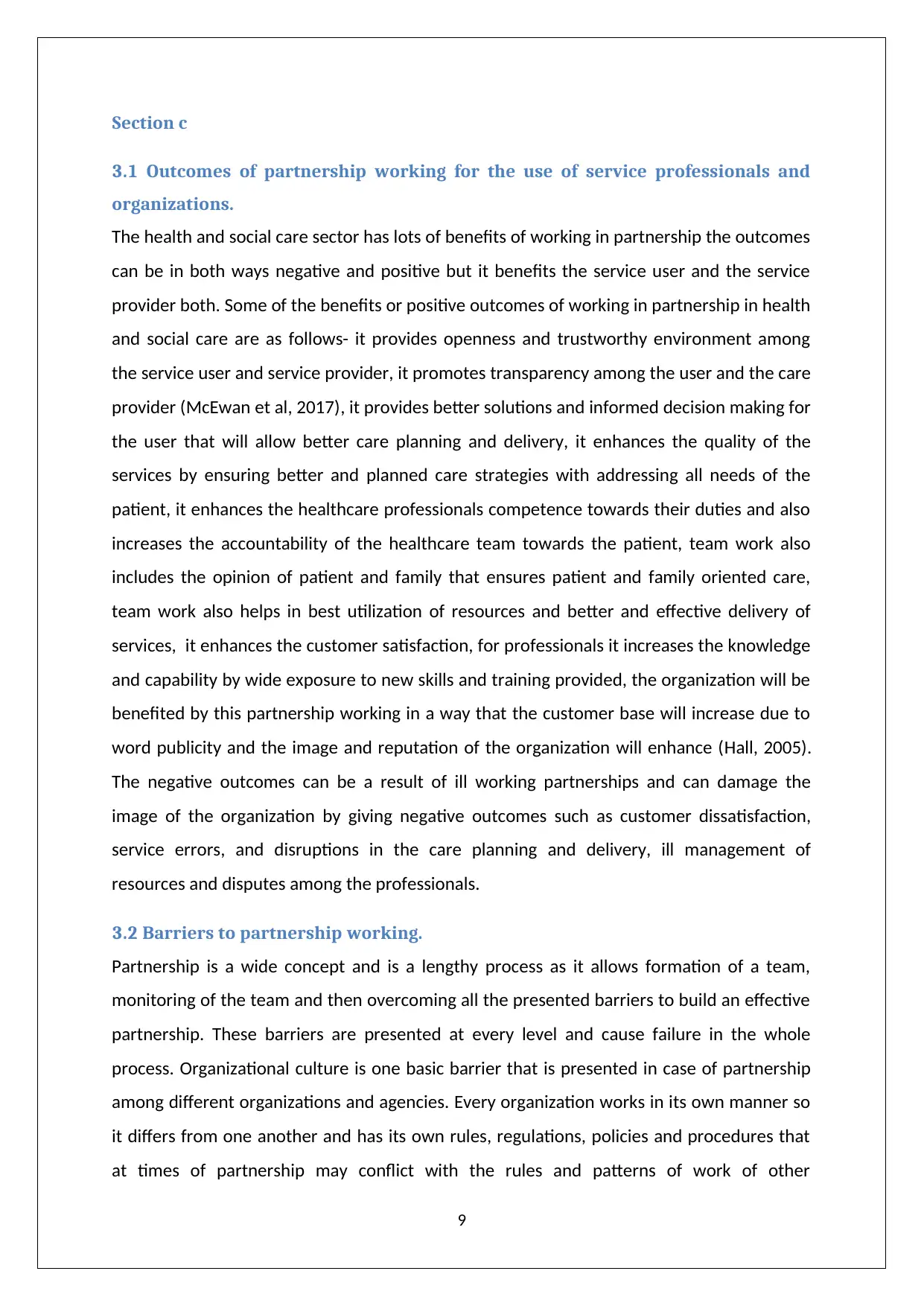
Section c
3.1 Outcomes of partnership working for the use of service professionals and
organizations.
The health and social care sector has lots of benefits of working in partnership the outcomes
can be in both ways negative and positive but it benefits the service user and the service
provider both. Some of the benefits or positive outcomes of working in partnership in health
and social care are as follows- it provides openness and trustworthy environment among
the service user and service provider, it promotes transparency among the user and the care
provider (McEwan et al, 2017), it provides better solutions and informed decision making for
the user that will allow better care planning and delivery, it enhances the quality of the
services by ensuring better and planned care strategies with addressing all needs of the
patient, it enhances the healthcare professionals competence towards their duties and also
increases the accountability of the healthcare team towards the patient, team work also
includes the opinion of patient and family that ensures patient and family oriented care,
team work also helps in best utilization of resources and better and effective delivery of
services, it enhances the customer satisfaction, for professionals it increases the knowledge
and capability by wide exposure to new skills and training provided, the organization will be
benefited by this partnership working in a way that the customer base will increase due to
word publicity and the image and reputation of the organization will enhance (Hall, 2005).
The negative outcomes can be a result of ill working partnerships and can damage the
image of the organization by giving negative outcomes such as customer dissatisfaction,
service errors, and disruptions in the care planning and delivery, ill management of
resources and disputes among the professionals.
3.2 Barriers to partnership working.
Partnership is a wide concept and is a lengthy process as it allows formation of a team,
monitoring of the team and then overcoming all the presented barriers to build an effective
partnership. These barriers are presented at every level and cause failure in the whole
process. Organizational culture is one basic barrier that is presented in case of partnership
among different organizations and agencies. Every organization works in its own manner so
it differs from one another and has its own rules, regulations, policies and procedures that
at times of partnership may conflict with the rules and patterns of work of other
9
3.1 Outcomes of partnership working for the use of service professionals and
organizations.
The health and social care sector has lots of benefits of working in partnership the outcomes
can be in both ways negative and positive but it benefits the service user and the service
provider both. Some of the benefits or positive outcomes of working in partnership in health
and social care are as follows- it provides openness and trustworthy environment among
the service user and service provider, it promotes transparency among the user and the care
provider (McEwan et al, 2017), it provides better solutions and informed decision making for
the user that will allow better care planning and delivery, it enhances the quality of the
services by ensuring better and planned care strategies with addressing all needs of the
patient, it enhances the healthcare professionals competence towards their duties and also
increases the accountability of the healthcare team towards the patient, team work also
includes the opinion of patient and family that ensures patient and family oriented care,
team work also helps in best utilization of resources and better and effective delivery of
services, it enhances the customer satisfaction, for professionals it increases the knowledge
and capability by wide exposure to new skills and training provided, the organization will be
benefited by this partnership working in a way that the customer base will increase due to
word publicity and the image and reputation of the organization will enhance (Hall, 2005).
The negative outcomes can be a result of ill working partnerships and can damage the
image of the organization by giving negative outcomes such as customer dissatisfaction,
service errors, and disruptions in the care planning and delivery, ill management of
resources and disputes among the professionals.
3.2 Barriers to partnership working.
Partnership is a wide concept and is a lengthy process as it allows formation of a team,
monitoring of the team and then overcoming all the presented barriers to build an effective
partnership. These barriers are presented at every level and cause failure in the whole
process. Organizational culture is one basic barrier that is presented in case of partnership
among different organizations and agencies. Every organization works in its own manner so
it differs from one another and has its own rules, regulations, policies and procedures that
at times of partnership may conflict with the rules and patterns of work of other
9
⊘ This is a preview!⊘
Do you want full access?
Subscribe today to unlock all pages.

Trusted by 1+ million students worldwide
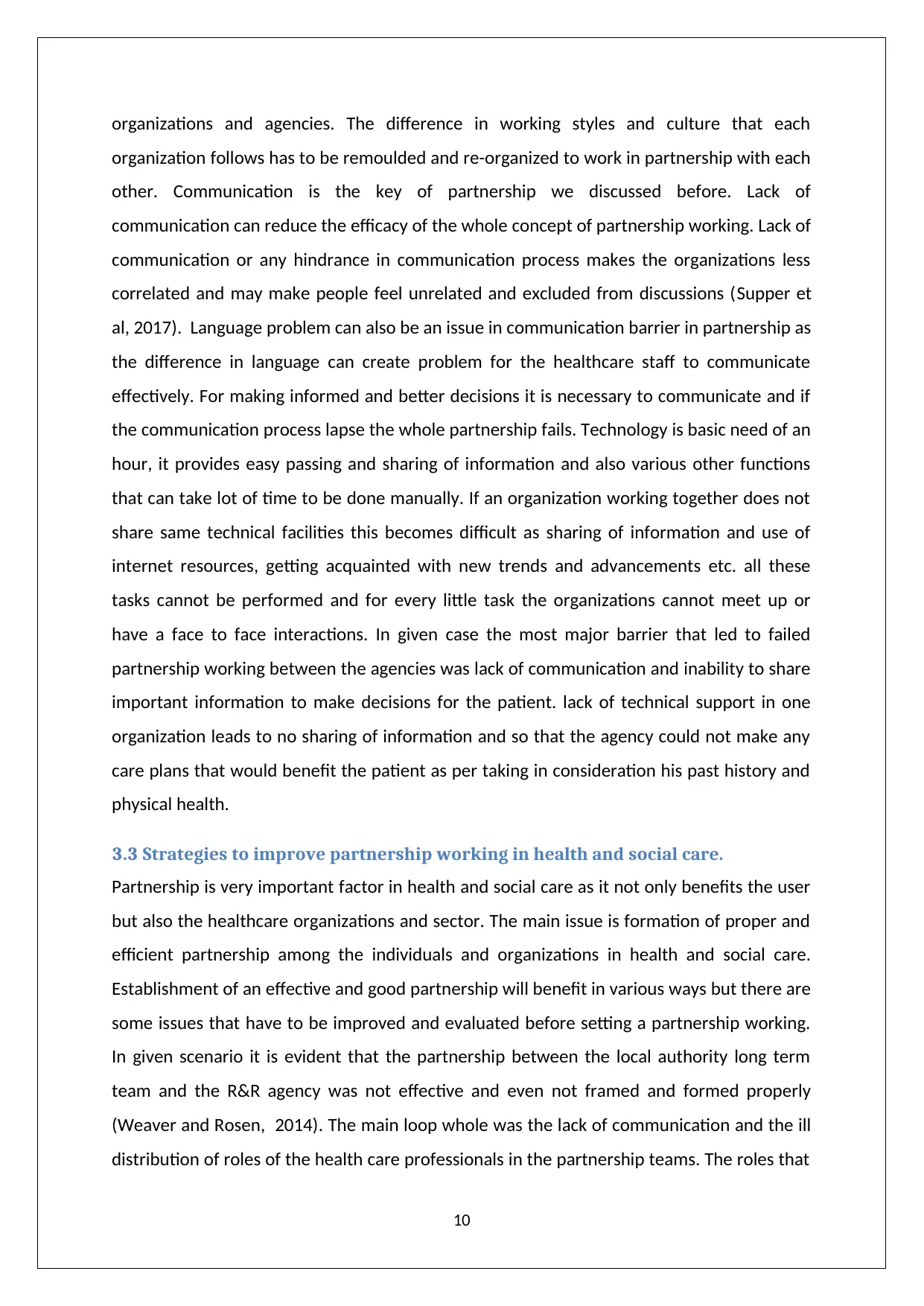
organizations and agencies. The difference in working styles and culture that each
organization follows has to be remoulded and re-organized to work in partnership with each
other. Communication is the key of partnership we discussed before. Lack of
communication can reduce the efficacy of the whole concept of partnership working. Lack of
communication or any hindrance in communication process makes the organizations less
correlated and may make people feel unrelated and excluded from discussions (Supper et
al, 2017). Language problem can also be an issue in communication barrier in partnership as
the difference in language can create problem for the healthcare staff to communicate
effectively. For making informed and better decisions it is necessary to communicate and if
the communication process lapse the whole partnership fails. Technology is basic need of an
hour, it provides easy passing and sharing of information and also various other functions
that can take lot of time to be done manually. If an organization working together does not
share same technical facilities this becomes difficult as sharing of information and use of
internet resources, getting acquainted with new trends and advancements etc. all these
tasks cannot be performed and for every little task the organizations cannot meet up or
have a face to face interactions. In given case the most major barrier that led to failed
partnership working between the agencies was lack of communication and inability to share
important information to make decisions for the patient. lack of technical support in one
organization leads to no sharing of information and so that the agency could not make any
care plans that would benefit the patient as per taking in consideration his past history and
physical health.
3.3 Strategies to improve partnership working in health and social care.
Partnership is very important factor in health and social care as it not only benefits the user
but also the healthcare organizations and sector. The main issue is formation of proper and
efficient partnership among the individuals and organizations in health and social care.
Establishment of an effective and good partnership will benefit in various ways but there are
some issues that have to be improved and evaluated before setting a partnership working.
In given scenario it is evident that the partnership between the local authority long term
team and the R&R agency was not effective and even not framed and formed properly
(Weaver and Rosen, 2014). The main loop whole was the lack of communication and the ill
distribution of roles of the health care professionals in the partnership teams. The roles that
10
organization follows has to be remoulded and re-organized to work in partnership with each
other. Communication is the key of partnership we discussed before. Lack of
communication can reduce the efficacy of the whole concept of partnership working. Lack of
communication or any hindrance in communication process makes the organizations less
correlated and may make people feel unrelated and excluded from discussions (Supper et
al, 2017). Language problem can also be an issue in communication barrier in partnership as
the difference in language can create problem for the healthcare staff to communicate
effectively. For making informed and better decisions it is necessary to communicate and if
the communication process lapse the whole partnership fails. Technology is basic need of an
hour, it provides easy passing and sharing of information and also various other functions
that can take lot of time to be done manually. If an organization working together does not
share same technical facilities this becomes difficult as sharing of information and use of
internet resources, getting acquainted with new trends and advancements etc. all these
tasks cannot be performed and for every little task the organizations cannot meet up or
have a face to face interactions. In given case the most major barrier that led to failed
partnership working between the agencies was lack of communication and inability to share
important information to make decisions for the patient. lack of technical support in one
organization leads to no sharing of information and so that the agency could not make any
care plans that would benefit the patient as per taking in consideration his past history and
physical health.
3.3 Strategies to improve partnership working in health and social care.
Partnership is very important factor in health and social care as it not only benefits the user
but also the healthcare organizations and sector. The main issue is formation of proper and
efficient partnership among the individuals and organizations in health and social care.
Establishment of an effective and good partnership will benefit in various ways but there are
some issues that have to be improved and evaluated before setting a partnership working.
In given scenario it is evident that the partnership between the local authority long term
team and the R&R agency was not effective and even not framed and formed properly
(Weaver and Rosen, 2014). The main loop whole was the lack of communication and the ill
distribution of roles of the health care professionals in the partnership teams. The roles that
10
Paraphrase This Document
Need a fresh take? Get an instant paraphrase of this document with our AI Paraphraser
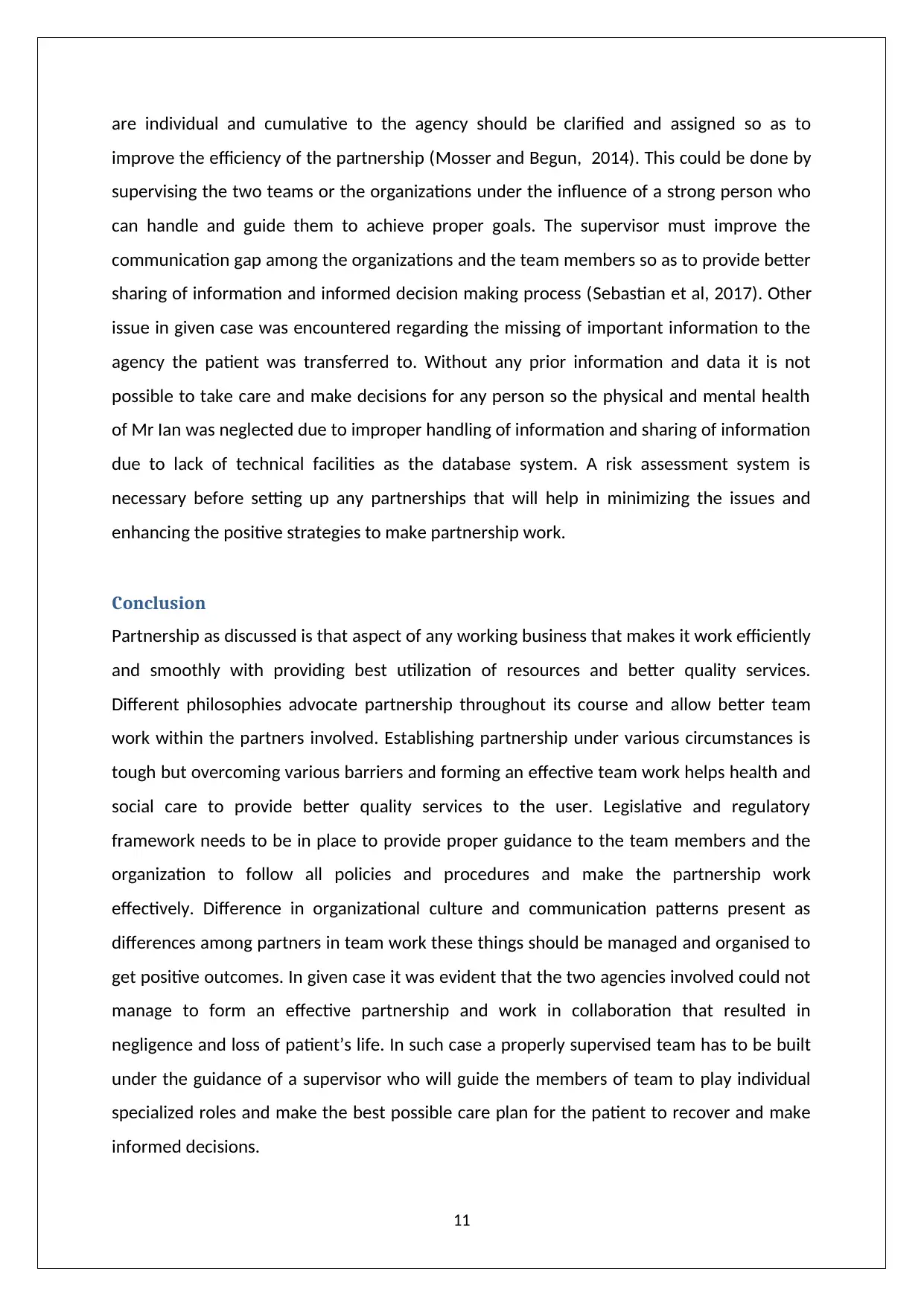
are individual and cumulative to the agency should be clarified and assigned so as to
improve the efficiency of the partnership (Mosser and Begun, 2014). This could be done by
supervising the two teams or the organizations under the influence of a strong person who
can handle and guide them to achieve proper goals. The supervisor must improve the
communication gap among the organizations and the team members so as to provide better
sharing of information and informed decision making process (Sebastian et al, 2017). Other
issue in given case was encountered regarding the missing of important information to the
agency the patient was transferred to. Without any prior information and data it is not
possible to take care and make decisions for any person so the physical and mental health
of Mr Ian was neglected due to improper handling of information and sharing of information
due to lack of technical facilities as the database system. A risk assessment system is
necessary before setting up any partnerships that will help in minimizing the issues and
enhancing the positive strategies to make partnership work.
Conclusion
Partnership as discussed is that aspect of any working business that makes it work efficiently
and smoothly with providing best utilization of resources and better quality services.
Different philosophies advocate partnership throughout its course and allow better team
work within the partners involved. Establishing partnership under various circumstances is
tough but overcoming various barriers and forming an effective team work helps health and
social care to provide better quality services to the user. Legislative and regulatory
framework needs to be in place to provide proper guidance to the team members and the
organization to follow all policies and procedures and make the partnership work
effectively. Difference in organizational culture and communication patterns present as
differences among partners in team work these things should be managed and organised to
get positive outcomes. In given case it was evident that the two agencies involved could not
manage to form an effective partnership and work in collaboration that resulted in
negligence and loss of patient’s life. In such case a properly supervised team has to be built
under the guidance of a supervisor who will guide the members of team to play individual
specialized roles and make the best possible care plan for the patient to recover and make
informed decisions.
11
improve the efficiency of the partnership (Mosser and Begun, 2014). This could be done by
supervising the two teams or the organizations under the influence of a strong person who
can handle and guide them to achieve proper goals. The supervisor must improve the
communication gap among the organizations and the team members so as to provide better
sharing of information and informed decision making process (Sebastian et al, 2017). Other
issue in given case was encountered regarding the missing of important information to the
agency the patient was transferred to. Without any prior information and data it is not
possible to take care and make decisions for any person so the physical and mental health
of Mr Ian was neglected due to improper handling of information and sharing of information
due to lack of technical facilities as the database system. A risk assessment system is
necessary before setting up any partnerships that will help in minimizing the issues and
enhancing the positive strategies to make partnership work.
Conclusion
Partnership as discussed is that aspect of any working business that makes it work efficiently
and smoothly with providing best utilization of resources and better quality services.
Different philosophies advocate partnership throughout its course and allow better team
work within the partners involved. Establishing partnership under various circumstances is
tough but overcoming various barriers and forming an effective team work helps health and
social care to provide better quality services to the user. Legislative and regulatory
framework needs to be in place to provide proper guidance to the team members and the
organization to follow all policies and procedures and make the partnership work
effectively. Difference in organizational culture and communication patterns present as
differences among partners in team work these things should be managed and organised to
get positive outcomes. In given case it was evident that the two agencies involved could not
manage to form an effective partnership and work in collaboration that resulted in
negligence and loss of patient’s life. In such case a properly supervised team has to be built
under the guidance of a supervisor who will guide the members of team to play individual
specialized roles and make the best possible care plan for the patient to recover and make
informed decisions.
11
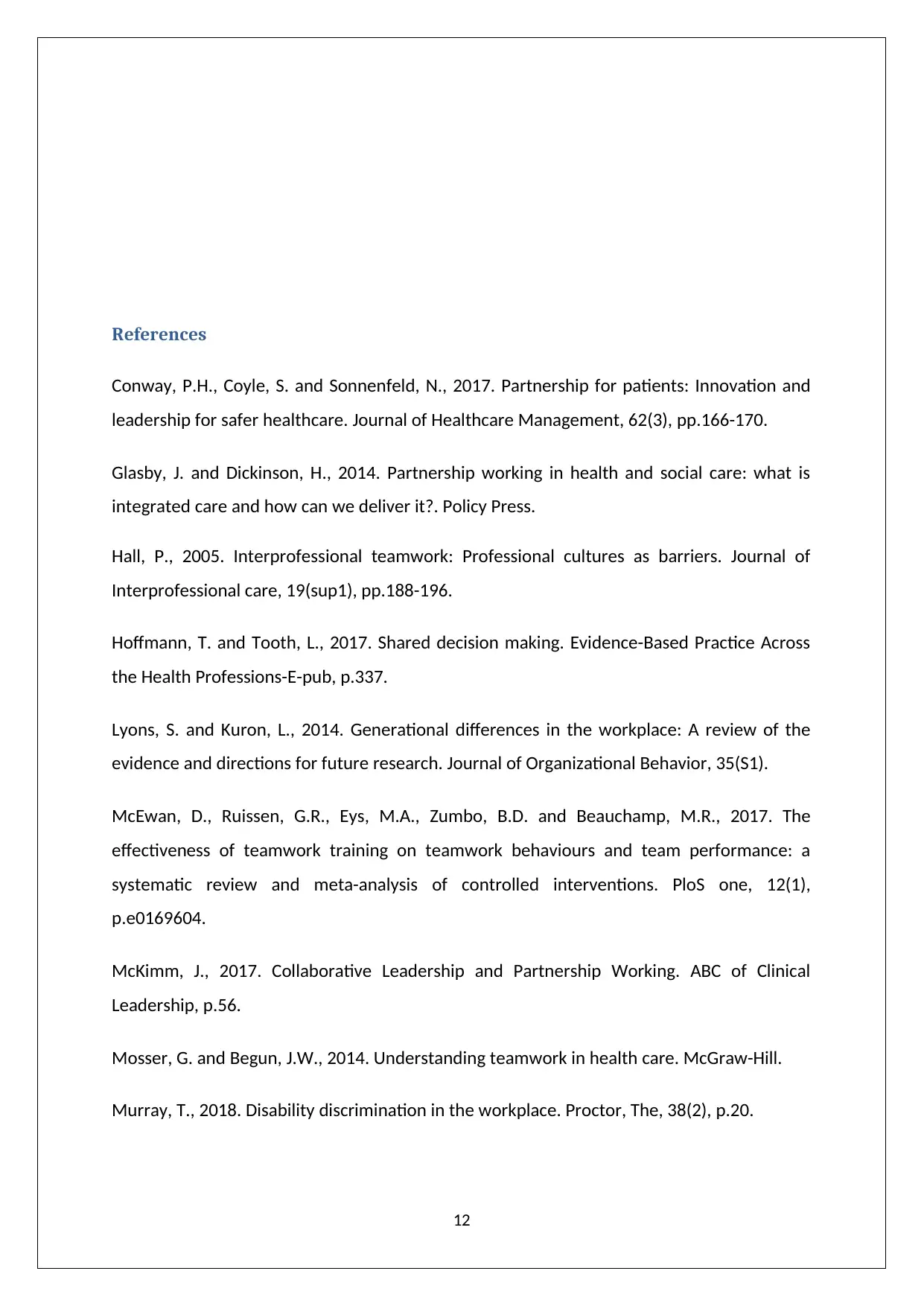
References
Conway, P.H., Coyle, S. and Sonnenfeld, N., 2017. Partnership for patients: Innovation and
leadership for safer healthcare. Journal of Healthcare Management, 62(3), pp.166-170.
Glasby, J. and Dickinson, H., 2014. Partnership working in health and social care: what is
integrated care and how can we deliver it?. Policy Press.
Hall, P., 2005. Interprofessional teamwork: Professional cultures as barriers. Journal of
Interprofessional care, 19(sup1), pp.188-196.
Hoffmann, T. and Tooth, L., 2017. Shared decision making. Evidence-Based Practice Across
the Health Professions-E-pub, p.337.
Lyons, S. and Kuron, L., 2014. Generational differences in the workplace: A review of the
evidence and directions for future research. Journal of Organizational Behavior, 35(S1).
McEwan, D., Ruissen, G.R., Eys, M.A., Zumbo, B.D. and Beauchamp, M.R., 2017. The
effectiveness of teamwork training on teamwork behaviours and team performance: a
systematic review and meta-analysis of controlled interventions. PloS one, 12(1),
p.e0169604.
McKimm, J., 2017. Collaborative Leadership and Partnership Working. ABC of Clinical
Leadership, p.56.
Mosser, G. and Begun, J.W., 2014. Understanding teamwork in health care. McGraw-Hill.
Murray, T., 2018. Disability discrimination in the workplace. Proctor, The, 38(2), p.20.
12
Conway, P.H., Coyle, S. and Sonnenfeld, N., 2017. Partnership for patients: Innovation and
leadership for safer healthcare. Journal of Healthcare Management, 62(3), pp.166-170.
Glasby, J. and Dickinson, H., 2014. Partnership working in health and social care: what is
integrated care and how can we deliver it?. Policy Press.
Hall, P., 2005. Interprofessional teamwork: Professional cultures as barriers. Journal of
Interprofessional care, 19(sup1), pp.188-196.
Hoffmann, T. and Tooth, L., 2017. Shared decision making. Evidence-Based Practice Across
the Health Professions-E-pub, p.337.
Lyons, S. and Kuron, L., 2014. Generational differences in the workplace: A review of the
evidence and directions for future research. Journal of Organizational Behavior, 35(S1).
McEwan, D., Ruissen, G.R., Eys, M.A., Zumbo, B.D. and Beauchamp, M.R., 2017. The
effectiveness of teamwork training on teamwork behaviours and team performance: a
systematic review and meta-analysis of controlled interventions. PloS one, 12(1),
p.e0169604.
McKimm, J., 2017. Collaborative Leadership and Partnership Working. ABC of Clinical
Leadership, p.56.
Mosser, G. and Begun, J.W., 2014. Understanding teamwork in health care. McGraw-Hill.
Murray, T., 2018. Disability discrimination in the workplace. Proctor, The, 38(2), p.20.
12
⊘ This is a preview!⊘
Do you want full access?
Subscribe today to unlock all pages.

Trusted by 1+ million students worldwide
1 out of 13
Related Documents
Your All-in-One AI-Powered Toolkit for Academic Success.
+13062052269
info@desklib.com
Available 24*7 on WhatsApp / Email
![[object Object]](/_next/static/media/star-bottom.7253800d.svg)
Unlock your academic potential
Copyright © 2020–2025 A2Z Services. All Rights Reserved. Developed and managed by ZUCOL.





